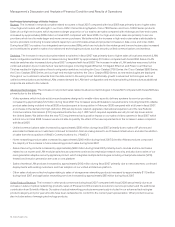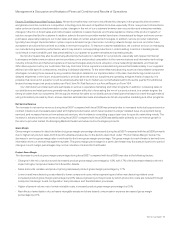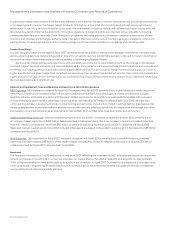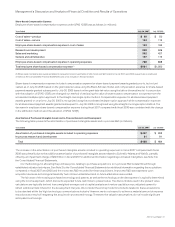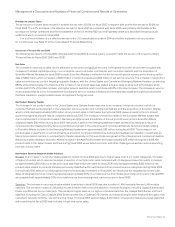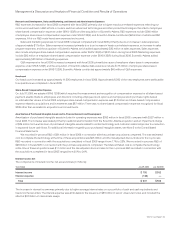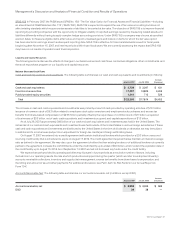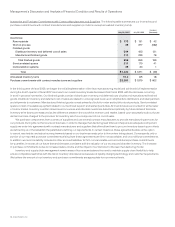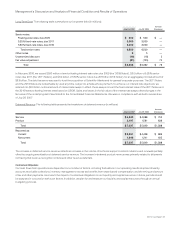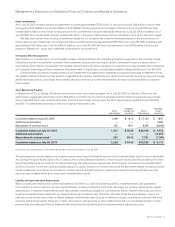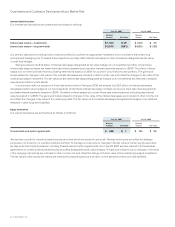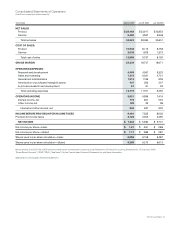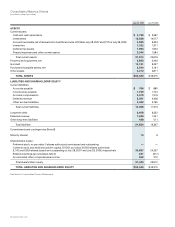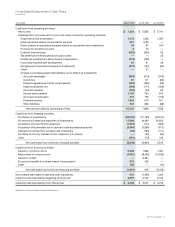Cisco 2007 Annual Report Download - page 35
Download and view the complete annual report
Please find page 35 of the 2007 Cisco annual report below. You can navigate through the pages in the report by either clicking on the pages listed below, or by using the keyword search tool below to find specific information within the annual report.
38 Cisco Systems, Inc.
Management’s Discussion and Analysis of Financial Condition and Results of Operations
Inventories and Purchase Commitments with Contract Manufacturers and Suppliers The following table summarizes our inventories and
purchase commitments with contract manufacturers and suppliers (in millions, except annualized inventory turns):
July 29, 2006
Increase
(Decrease)July 28, 2007
Inventories:
Raw materials $ 173 $ 131 $ 42
Work in process 45 377 (332)
Finished goods:
Distributor inventory and deferred cost of sales 544 423 121
Manufactured finished goods 314 236 78
Total finished goods 858 659 199
Service-related spares 211 170 41
Demonstration systems 35 34 1
Total $ 1,322 $ 1,371 $ (49)
Annualized inventory turns 10.3 8.5 1.8
Purchase commitments with contract manufacturers and suppliers $ 2,581 $ 1,979 $ 602
In the third quarter of fiscal 2006, we began the initial implementation of the lean manufacturing model and achieved full implementation
during the fourth quarter of fiscal 2007. As a result, our overall inventory levels decreased from fiscal 2006, with the decrease occurring
in work in process inventories. Our finished goods consist of distributor inventory and deferred cost of sales and manufactured finished
goods. Distributor inventory and deferred cost of sales are related to unrecognized revenue on shipments to distributors and retail partners
and shipments to customers. Manufactured finished goods consist primarily of build-to-order and build-to-stock products. Service-related
spares consist of reusable equipment related to our technical support and warranty activities. All inventories are accounted for at the lower
of cost or market. Inventory is written down based on excess and obsolete inventories determined primarily by future demand forecasts.
Inventory write downs are measured as the difference between the cost of the inventory and market, based upon assumptions about future
demand, and are charged to the provision for inventory, which is a component of our cost of sales.
We purchase components from a variety of suppliers and use several contract manufacturers to provide manufacturing services for
our products. During the normal course of business, in order to manage manufacturing lead times and help ensure adequate component
supply, we enter into agreements with contract manufacturers and suppliers that either allow them to procure inventory based upon criteria
as defined by us or that establish the parameters defining our requirements. In certain instances, these agreements allow us the option
to cancel, reschedule, and adjust our requirements based on our business needs prior to firm orders being placed. Consequently, only a
portion of our reported purchase commitments arising from these agreements are firm, noncancelable, and unconditional commitments.
In addition, we record a liability, included in other accrued liabilities, for firm, noncancelable, and unconditional purchase commitments
for quantities in excess of our future demand forecasts consistent with the valuation of our excess and obsolete inventory. The increase
in purchase commitments is due to increased sales volume and the impact of our transition to the lean manufacturing model.
Inventory and supply chain management remain areas of focus as we balance the need to maintain supply chain flexibility to help
ensure competitive lead times with the risk of inventory obsolescence because of rapidly changing technology and customer requirements.
We believe the amount of our inventory and purchase commitments are appropriate for our revenue levels.


